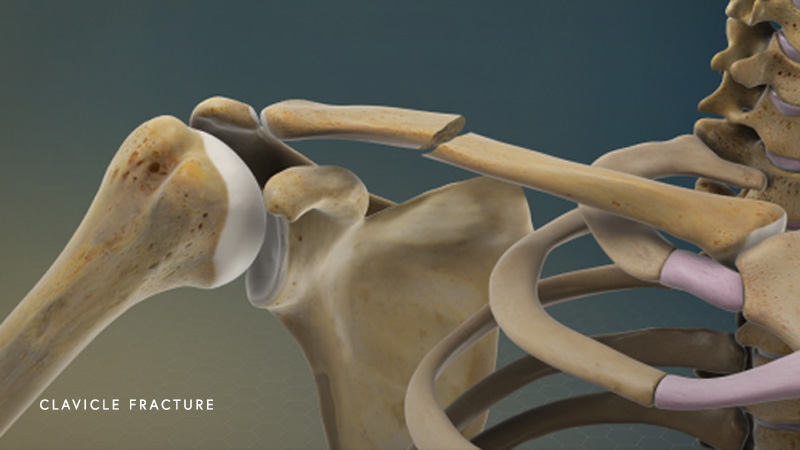Clavicle Fracture
The clavicle, or collarbone, is notoriously known to be one of the most commonly fractured parts of the human body. A clavicle fracture occurs when there has been a direct blow to the collarbone by direct impact.
The clavicle (collarbone) is located between the sternum (ribcage) and the scapula (shoulder blade). The clavicle connects the humerus to the torso in accordance with the scapula through the acromio clavicular joint of the clavicle. The sternal (medial) end of the clavicle connects the collarbone to the sternum and the acromial end connects to the acromio clavicular joint of the clavicle.
The clavicle functions as a strut to support the weight of the shoulder blades and arms. It also protects neurovascular structures within the body that supply the upper limb with force and transmits that force from the upper limb to the axial skeleton.
A clavicle fracture is among one of the most common injuries for individuals especially in active children and young adults. A clavicle fracture occurs when the collarbone is met with sudden or excessive monumental force, and the bone itself splits, fractures, or ultimately breaks entirely. Clavicle fractures are very common as they occur regularly in athletics, recreational sports, accidents, and other physical occurrences.

Common causes of a clavicle fracture include:
- Falling onto the body’s shoulder or outstretched hand. This extends the collar bone and opens it up for immediate and direct impact with the ground.
- Sports injuries such as direct blows to the shoulder, chest, shoulder blade, back, or the collarbone directly.
- Motor vehicle trauma/accidents. Air Bag impact on those too close to the dashboard has been known to increase the risk of a clavicle fracture.
- Birth injury from passing through the birth canal can cause clavicle fractures in newborns
- Those under the age of 20 years old with underdeveloped collarbones who participate in contact sports or recreational activities
- Elderly people with decreased bone density
There are many indications of a fractured clavicle. Most of which include:
- Swelling of the collarbone
- Tenderness of the collarbone
- Bruising
- A bulge on or near the shoulder
- Grinding or crackling sounds in the collarbone or shoulder
- Stiffness or inability to move the shoulder
- Pain that increases with shoulder movement
- Decreased range of motion in the shoulder
- Newborns will often not move their arm(s) for several days following a collarbone fracture resulting from passing through the birth canal
Symptoms of a clavicle fracture warrant immediate medical attention. Delays in diagnosis can alter and slow the healing progress and may result in many complications. These complications include the following:
Nerve Or Blood Vessel Injury
The jagged ends of a fractured clavicle can injure nearby nerves and blood vessels, leading to numbness of coldness in the arm or hand.
Poor Healing
A severely fractured clavicle may heal incompletely. Poor combination of the fractured parts of the bone during healing can shorten the bone.
A Lump In The Bone
The place where the bone comes together forms a bony lump as part of the healing process. Most lumps disappear over time, but some can be permanent.
Osteoarthritis
A fracture involving the joints that connect the clavicle to the scapula or the sternum might increase the risk of developing arthritis in the relative joint(s). Osteoarthritis is the inflammation of one or more joints typically in the hand, spine, knees, hips, and shoulders.
During the exam, the attending physician will check and test the clavicle for tenderness, swelling, deformities, and open wounds. XRays are most commonly used to determine the extent to which a clavicle is fractured or broken. The attending physician may also recommend a CT scan (CAT scan) to get more detailed images. A CT scan is an X-ray image rendered using a form of tomography in which a computer dictates the motion of the X-ray source, processes the data, and produces the image.
It is imperative to restrict the movement of a fractured or broken bone. Increased motion is detrimental to the healing process. Therefore, immobility of the fractured/broken bone is crucial to healing. In order to immobilize a fracture or break in the clavicle, it is highly recommended to wear an arm sling.
The duration of immobilization is entirely dependent on the severity of the injury and the required amount of time necessary for healing to occur. It typically takes three to six weeks for children and six to 12 weeks for adults for bones to mend and heal.
Medication
The severity of pain regarding a fractured or broken clavicle can be excruciating. In order to reduce pain and inflammation, a physician may recommend an over-the-counter pain reliever like ibuprofen. If the patient is experiencing severe pain, physicians may prescribe medication that contains a narcotic for a few days.
Surgery
Surgery may be necessary if the fractured clavicle has ruptured through the skin, or if the clavicle is severely displaced or in many pieces. Surgery usually includes placing fixation devices such as plates in the clavicle or screws or rods in order to maintain proper position of the bone during the healing process.
Rehabilitation
After receiving initial treatment it’s important to undergo some motion exercises to minimize stiffness in the shoulder while wearing the sling. After the sling is removed, the doctor may recommend additional physical therapy to restore muscle strength, joint motion and flexibility.
Schedule a consultation
If you’re experiencing any of the aforementioned symptoms of a clavicle fracture or have fractured your clavicle, it is vital to seek immediate attention from a medical professional. The Center for Orthopaedic Specialists is an elite team of medical professionals who have the expertise, education, and experience required to heal the ailments of any fracture. Contact the Center for Orthopaedic Specialists today if you are currently experiencing any restrictions in movement, pain, or have been diagnosed with a fracture.




 / 50 Reviews
/ 50 Reviews